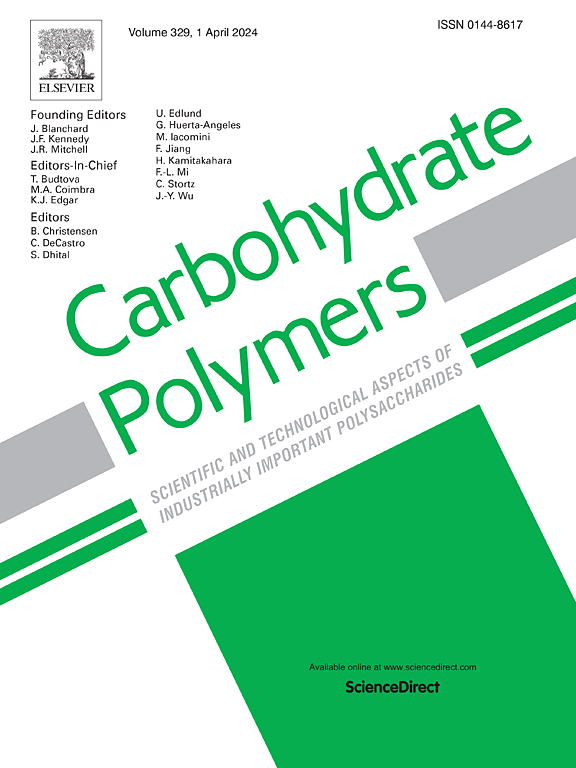Synthesis of N, N,O and O-carboxymethyl chitosan derivatives of controllable substitution degrees and their utilization as electrospun scaffolds for bone tissue engineering
IF 10.7
1区 化学
Q1 CHEMISTRY, APPLIED
引用次数: 0
Abstract
Most chitosan (CS) carboxymethylation approaches are weighed down by insufficient description protocols regarding the reaction specificity and the degree of substitution (DS). Here, we provide three carboxymethylation protocols of enhanced specificity towards the amine (N-), amine/hydroxy (N,O-) and hydroxy (O-) groups of CS. The DS for all samples was found to be ∼70 %, as confirmed by NMR analysis. To illustrate the modified materials' potential in bone tissue regeneration, each derivative was blended with poly(vinyl alcohol) to prepare scaffolds via electrospinning. Both materials and electrospun membranes were characterized in terms of their physicochemical properties by Fourier transform infrared spectroscopy, thermogravimetric analysis, differential scanning calorimetry and water contact angle measurements. The electrospun membranes' swelling ratio, degradation, tensile strength, as well as morphology were also examined through scanning electron microscopy before and after heat treatment at 120 °C, which was used as a method of physical stabilization, leading to significantly enhanced degradation rate and mechanical strength. The three electrospun scaffold types were loaded with MC3T3-E1 pre-osteoblastic cells and their cell adhesion, viability and growth rate were assessed. Finally, osteogenic differentiation was examined by means of alkaline phosphatase activity measurement, calcium mineralization and formation of extracellular matrix markers, with all materials showing promising prospects.
可控取代度的 N、N、O 和 O-羧甲基壳聚糖衍生物的合成及其作为骨组织工程电纺支架的应用
大多数壳聚糖(CS)羧甲基化方法都存在反应特异性和取代度(DS)描述不充分的问题。在此,我们提供了三种羧甲基化方案,分别针对 CS 的胺(N-)、胺/羟基(N,O-)和羟基(O-)基团,增强了特异性。经核磁共振分析证实,所有样品的 DS 均为±70%。为了说明改性材料在骨组织再生方面的潜力,将每种衍生物与聚乙烯醇混合,通过电纺丝技术制备支架。通过傅里叶变换红外光谱法、热重分析法、差示扫描量热法和水接触角测量法对两种材料和电纺膜的理化性质进行了表征。此外,还通过扫描电子显微镜观察了电纺膜在 120 ℃ 热处理前后的溶胀率、降解、拉伸强度和形貌,热处理是一种物理稳定化方法,可显著提高降解率和机械强度。用 MC3T3-E1 前成骨细胞负载三种类型的电纺支架,并评估其细胞粘附性、存活率和生长率。最后,通过测定碱性磷酸酶活性、钙矿化和细胞外基质标记物的形成,对成骨分化进行了检验,所有材料都显示出良好的前景。
本文章由计算机程序翻译,如有差异,请以英文原文为准。
求助全文
约1分钟内获得全文
求助全文
来源期刊

Carbohydrate Polymers
化学-高分子科学
CiteScore
22.40
自引率
8.00%
发文量
1286
审稿时长
47 days
期刊介绍:
Carbohydrate Polymers stands as a prominent journal in the glycoscience field, dedicated to exploring and harnessing the potential of polysaccharides with applications spanning bioenergy, bioplastics, biomaterials, biorefining, chemistry, drug delivery, food, health, nanotechnology, packaging, paper, pharmaceuticals, medicine, oil recovery, textiles, tissue engineering, wood, and various aspects of glycoscience.
The journal emphasizes the central role of well-characterized carbohydrate polymers, highlighting their significance as the primary focus rather than a peripheral topic. Each paper must prominently feature at least one named carbohydrate polymer, evident in both citation and title, with a commitment to innovative research that advances scientific knowledge.
 求助内容:
求助内容: 应助结果提醒方式:
应助结果提醒方式:


